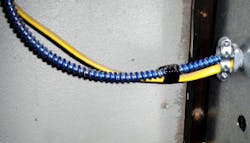Can you identify the Code violation(s) in this photo?
Hint: Making intimate contact
Find the Answer
How well do you know the Code? Think you can spot violations the original installer either ignored or couldn’t identify? Here’s your chance to moonlight as an electrical inspector and second-guess someone else’s work from the safety of your living room or office. Can you identify the Code violation(s) in this photo?
‘Tell Them What They’ve Won...’
Using the 2008 NEC, correctly identify the Code violation(s) in this month’s photo — in 200 words or less — and you could win something to put in your toolbox. E-mail your response to [email protected], and we’ll select three winners (excluding manufacturers and prior winners) at random from the correct submissions. Winners will receive a set of insulated hand tools from Ideal Industries, Inc., valued at more than $125.* The set includes 9.25-in. insulated side-cutting pliers, 10-in. insulated tongue-and-groove pliers, and a 0.25-in. 3 6-in. insulated screwdriver. (* Please allow six to eight weeks for delivery of tools.)
July Winners
Our two winners this month include: John Hemmings, an electrician from Diamond, W. Va., and Nikita Yakimov, an electrical mechanic with Firequench, Inc., Brooklyn, N.Y. Both readers properly identified this means of attachment as a violation of the NEC.
As noted in 800.133(B), “Raceways shall be used for their intended purpose. Communications cables or wires shall not be strapped, taped, or attached by any means to the exterior of any conduit or raceway as a means of support.” Although you might think this data cable installer was creative in using this pull string as a means of support, he did so at several locations along this run of cables. Because it was the only means of support, it violates NEC rules.
Another section of the Code that could be cited by the AHJ is 800.24, Mechanical Execution of Work. One sentence in this section states, “Such cables shall be secured by hardware, including straps, staples, cable ties, hangers, or similar fittings designed and installed so as not to damage the cable.” This pull string is obviously not designed as a support device.
About the Author
Joe Tedesco
Tedesco served the industry in many roles during his career. He was a director, senior electrical code instructor for National Technology Transfer, Inc. and American Trainco, Inc.. He was also a codes, standards and seminar specialist for the International Association of Electrical Inspectors and an electrical field service specialist for the National Fire Protection Association in Quincy, Mass. He ran his own business as an NEC consultant and is a Massachusetts licensed master electrician and journeyman electrician and certified electrical inspector (one and two family 2A; General 2B, and Plan Review, 2C). Tedesco also wrote articles for CEE News and EC&M (Code Violations Illustrated and What's Wrong Here?) for more than 15 years and helped launched the Moving Violations video series.
